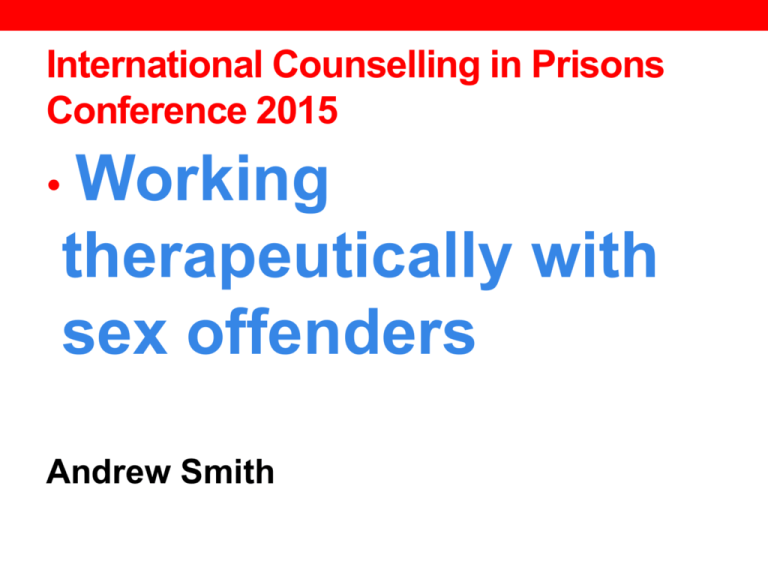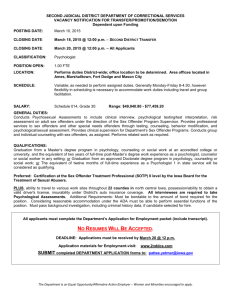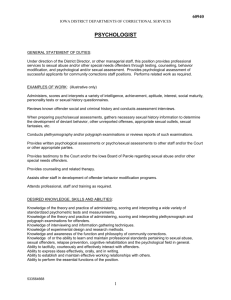
International Counselling in Prisons
Conference 2015
•
Working
therapeutically with
sex offenders
Andrew Smith
Aims of talk
• Why work therapeutically with sex offenders?
• Orthodox treatment approaches with sex
offenders?
• Strengths-based therapeutic approaches
• The challenges of forming a therapeutic
relationship and the offender constructing a
pro-social, good self
• How the therapeutic relationship can help
offenders construct pro-social identities and
lifestyles
Why work therapeutically with sex
offenders?
• Would we ask this question with any
other client group?
• Sex offenders have other problems too
• To provide a stake in society
• To help prevent deviant fantasies
turning into sexual offending
• To help family members cope with the
fallout
Why work therapeutically with sex
offenders
• In 2013 CEOP (Child
Exploitation and On-Line
Protection Centre) estimates
that 50,000 people in UK (vast
majority men) are viewing
indecent images of children
online
5
Director General of National Crime
Agency: October 2014
•“There is going to have to
be a range of interventions
which might fall short, for
some of the lower risk
(internet) offenders …
standing in court”
6
• Specialist Treatment Organisation for the
Prevention of Sexual Offending
• StopSO is an independent national group
of professionals including psychologists,
psychotherapists and doctors
• We treat people who behave in a sexually
inappropriate manner and are at risk of
sexual offending or re-offending
• We also offer support for their families
Orthodox treatment approaches with
sex offenders
• Motivation
• Illegal sexual fantasy
• Masturbation/orgasm
• Target victim
• Fantasy rehearsal
• Groom others/groom victim
• Abuse
• Fear and guilt
• Fantasy reinforcement
• Wolf’s Cycle (1984)
Orthodox treatment approaches with sex
offenders?
1. Motivation to sexually offend
2. Overcome internal inhibitors
3. Overcome external inhibitors
4. Overcome victim resistance
Pre-conditions to sexual offending
Ref:- D Finkelhor (1986)
Orthodox treatment approaches with
sex offenders
• Mark (1992): much treatment on the
1980s and 1990s (mostly in prison
and by probation service) involved
structured, confrontational
interviews, pressurising the
offender to describe sexual offence
in detail and in terms of various
cycles and models, notably the
models of Wolf and Finkelhor
Motivational Interviewing: Miller and Rollnick (1991); Baim
and Roberts (1999); Mann et al. (2002); McMurran (2002).
•
•
•
•
•
•
•
Expressing empathy
Following path of least resistance
Avoiding arguments
Emphasising client choice
Eliciting self-motivating statements
Socratic questioning
Creating cognitive dissonance
Orthodox treatment approaches with
sex offenders
• Reducing denial and minimization
• 2. Restructuring cognitive distortions
• 3. Improving victim empathy
• 4. Modifying deviant fantasy/arousal
• 5. Non-offence-specific treatment goals
• 6. Relapse prevention
• Brown (2005) Common treatment goals
Strengths-based therapeutic approaches:
• Ways of working with
individuals within their own
motivational frame of reference,
to bring about desired change
which focuses upon resources
and strengths, rather than
deficits and weaknesses
Good Lives: 4 needs and desires
adapted from Ward and Maruna (2007)
• The need and desire for Life (survival,
safety, procreation, sex)
• The need and desire for Relationships
(intimate, social and sexual)
• The need and desire for Significance
(autonomy, power, competence,
excitement)
• The need and desire for Inner Peace
(positive self-image, meaning to life)
Good Lives: Activities and Preoccupations
• Occupation
• Criminality
• Dancing
• Stealing cars
• Collecting
• Collecting illegal
stamps
• Good sex life
with partner
pornography
• Deviant Fantasy
Good Lives: Activities and preoccupations
Needs/Desires
Friendship
Relationships
Community
Excellence
Activities/
Preoccupations
Drug abuse
Internet
offending
Activities/
Preoccupations
Relating to
criminals
and victims
Needs/Desires
Friendship
Relationships
Community
Excellence
Activities/
Preoccupations
Satisfying
employment
Playing football
Activities/
Preoccupations
Relating to noncriminals and
appropriate
partners
Desistance:
Burnett (1992, 1994); Maruna (2001); Farrall (2002, 2004); Shover and
Thompson (1992); Sampson and Laub (1993); McNeill (2005); Maruna and Farrall (2004)
• Primary desistance
• Crime free gap in fluctuating criminal career
• Satisfying accommodation, occupation and
relationships (Social Capital)
• Social skills, emotional management (Human
Capital)
• Secondary desistance
• Shift in personal identity
• Redemptive Scripts (Maruna, 2001, McNeill,
2009)
Hudson (2005) Offending Identities
• Stigma (Goffman, 1963)
• ‘Extended social identity’
(Breakwell, 2001; Duveen, 2001)
• ‘Master status’ (Becker, 1963)
• ‘Bearers of risk’ (Ward, 2007)
• Socially constructed stigma around
sex offending becomes internalised
Construction of ‘Good Self’
• The individual needs a logical,
believable and respectable story
that makes it “impossible to engage
in criminal conduct without
arousing guilt reactions and shame
that are incompatible with self
conception” (Cressey, 1963)
How the therapeutic relationship
underpins it all
Importance of therapeutic relationship
regardless of model used (Hubble, 1999,
Lambert, 1992; Paul and Charura, 2014)
Research suggest good outcomes with
sex offenders also significantly depends
on the quality of the therapeutic skills of
the practitioner (Beech and Fordham,
1997; Marshall, 2003; Mann et al 2002;
Sandhu and Rose, 2012)
The challenges of forming a therapeutic relationship
and the offender constructing a pro-social, good self
• No other social pressures are
potentially so explosive as those which
constrain sexual relations
(Anthropologist Mary Douglas, 1966)
• The ‘visceral clutch’ is a term used to
illustrate the often gut reaction of horror
associated with child abuse (Rogers and
Stainton, 1992)
The challenges of forming a therapeutic relationship
and the offender constructing a pro-social, good self
• His sexual activity I just found
so depraved and bizarre … and
during the interview I wanted to
get up and walk out … but they
are individuals who need
respect even if they haven’t
dished an awful lot out (PO14)
The challenges of forming a therapeutic relationship
and the offender constructing a pro-social, good self
talking about infant
children I find particularly
difficult. I used to find it
difficult when the ages of the
victims were similar to the
ages of my children (PO16)
•…
The challenges of forming a therapeutic relationship
and the offender constructing a pro-social, good self
• Yeah, I said that at the beginning, didn’t I, that I
couldn’t empathise with them and maybe on one hand
I don’t want to, and maybe that is your safeguard for
yourself, that you don’t empathise with them. It
sounds awful, but do they deserve now to have a
happy life, to get on with it? That comes into play
sometimes. I like to say ‘yes they do,’ but there’s, you
know … With sex offenders, I do hope that they go on
to have more productive lives, then a prejudice and I
suppose ... I hope it’s not that pleasant (PO 9)
The challenges of forming a therapeutic relationship
and the offender constructing a pro-social, good self
There was something about his
whole demeanour I didn’t like …
something that I couldn’t put my
finger on. The guy I mentioned
before, with two rape convictions. I
would certainly go out for a drink
with him. I wouldn’t go out with the
other guy (PO15)
The challenges of forming a therapeutic relationship
and the offender constructing a pro-social, good self
•“I know that change in
that sort of offence is
quite unlikely, isn’t it?
You are helping them to
progress, perhaps, not
change.” PO 6
The challenges of forming a therapeutic relationship
and the offender constructing a pro-social, good self
• “Personally speaking, I see more
change with sex offenders than people
who offend generally, much more than
people who offend, of a physically
violent nature … I think people who
have been caught committing sex
offences are generally more compliant
and more motivated to work and cooperate and change.” PO 7
The challenges of forming a therapeutic relationship
and the offender constructing a pro-social, good self
• I think the self-esteem during
the actual therapeutic process
was still fairly low; the whole
sense of devastation, shame …
having particularly from me
professional background …
having acted in this appalling
way was very difficult (O8)
The challenges of forming a therapeutic relationship
and the offender constructing a pro-social, good self
• The loss of family, friends,
occupation, and community.
The very human and social
capital Primary Desistance
posits is so important for
living an offence-free life
The challenges of forming a therapeutic relationship
and the offender constructing a pro-social, good self
• I don’t see anyone. I don’t really bother with anybody
•
•
•
•
… I’ve lost everyone (O14)
I did have a lot of friends out there. There have been
shattered really, quite shattered (O11)
People thinking there’s a bloody paedophile walking
down the street (O6)
Obviously, it wouldn’t be right to get into a
relationship and let it develop, and then declare, ‘well
listen love, I’m a convicted rapist (O10)
My biggest challenge because my conviction being a
sexual offence is getting back into employment (O11)
The challenges of forming a therapeutic relationship
and the offender constructing a pro-social, good self
• I used to write everything down, the time I
went out of the house, the time I came back.
You need to go to the toilet. There could be
kids in there. I make sure nobody in there
before I go in. Not because I’m afraid of
anything happening, but in case something
does happen … and somebody seen me in
there and say ‘well he’s a sex offender and
you got a hell of a job to prove you’re
innocent after that (O1)
The challenges of forming a therapeutic relationship
and the offender constructing a pro-social, good self
• Foucault (1977) notes how in the 18C/19C The
Panopticon was a prison central tower ensuring
maximum visibility of prisoners, although from
moment to moment prisoners were not sure if there
were being observed or not leading to heigtened self
vigilance. Foucault suggests The Panopticon is a
metaphor of how power and control is regulated by
the modern state
• Parton (2006) refers to this regulation as ‘Soul
Training’ through (sex offender register, court orders,
forms of rehabilitation) which encouraged reflection
on the minutia of behaviour
How the therapeutic relationship can help
offenders construct pro-social identities and lifestyles
• Philosopher Charles Taylor (1989) posited that
is related to how human beings orient
themselves to what they perceive as good,
with self constructed through language in
relation to others.
• “I am self only in relation to certain
interlocutors: in relation to those
conversational partners who are essential to
my achieving self-definition”
How the therapeutic relationship can help
offenders construct pro-social identities and lifestyles
•Communicating
‘Unconditional
Regard
(Carl Rogers: threecore conditions)
How the therapeutic relationship can help
offenders construct pro-social identities and lifestyles
• … you hear somebody’s voice on
the telephone, and you take a
perception by the tone, by the way
they use language, of how that
person is. So I perceived that (my
probation officer) was going to be a
good guy, and fair dos, he was a
good guy (O6)
How the therapeutic relationship can help
offenders construct pro-social identities and lifestyles
•Empathy
(Carl Rogers: threecore conditions)
How the therapeutic relationship can help
offenders construct pro-social identities and lifestyles
• She’s sincere. It hasn’t taken her
long to suss me out. She knows
just by the way I talk. If I start to get
anxious, if I git this problem, maybe
that’s like a warning to her … if I
start getting some CDs (cognitive
distortions) she can see that it’s a
slight warning sign for me. (O13)
How the therapeutic relationship can help
offenders construct pro-social identities and lifestyles
•Communicating
Genuiness/Congruence
(Carl Rogers: three coreconditions)
How the therapeutic relationship can help
offenders construct pro-social identities and lifestyles
• She said, “I’m here to help, I'm here to
work with you. I don’t want to see you
go back into prison, and I don't want to
put you back into prison, but
understand, for the safety of yourself
and the safety of public protection, if I
have to, if you give me grounds to, I
will.” And I thought, fair enough (O9)
How the therapeutic relationship can help
offenders construct pro-social identities and lifestyles
• Moving offenders from shame
to guilt, as guilt is less ego
threatening than shame as it
involves a focus on behaviour
rather than a global sense of
fallen self (Tangney and Dearing,
2002)
How the therapeutic relationship can help
offenders construct pro-social identities and lifestyles
• However, Braithwaite (1989) concept of
‘integrative shaming’ can be positive if
institutional space can be created in terms of
restorative justice initiatives (i.e letter of
apologies in treatment programmes)
• The Therapeutic Relationship can also be an
institutional space for the constructive
management of shame, facilitating the
offender’s journey from an anti-social
demonised identity into a pro-social
integrated self
How the therapeutic relationship can help
offenders construct pro-social identities and lifestyles
• ‘Normative compliance’
based upon moral obligation
rather than ‘instrumental
compliance’ based upon
deterrents and incentives
• Bottoms (2001)
How the therapeutic relationship can help
offenders construct pro-social identities and lifestyles
•It would be like letting him
down if I re-offended. He’s
like the main person I can
visualise, also can inspire
me to not reoffend. He’s
put faith in me (O2)
How the therapeutic relationship can help
offenders construct pro-social identities and lifestyles
• I realise that there’s such a lot of things in life
that you can do and be involved in that aren’t
motivated by sex … I don’t see them (teenage
boys) as sexual targets if you like. I’m happy
with the sex life I have with my partner, with
life beyond sex. I’m bi sexual and accept that.
I don’t think I’ll ever get rid of the attraction or
the thought of it. But I don’t want to (offend).
The fact that it would be destructive to me, to
the person, destructive to my family (05)
Identity formed through how we orientate
ourselves to shifting and preferred values
• I think I put this front on, this
model parolee, and I led a secret
life. I would come in (to the
sessions) and everything would
be fine and rosy, but my life
would be in fucking chaos (O10)
Identity formed through how we orientate ourselves
to shifting and preferred values
• I’m a Buddist … I started looking
into the Arts, and that opened a
whole different world to me. I
wasn’t interested before, only cared
about myself. I failed to realise how
selfish I was, or have any
awareness of all the people I hurt.
But that realisation doesn’t happen
overnight (O10)
Offender 10 described Gestalt-type
moments
• I have empathy with things
now, where I didn’t before. I
knew about this psychopath
… but in actual fact it was me
if you don’t give a toss about
people (O10)
Useful references
• Andrews, D.A. and Bonta, J. (2003) The Psychology of Criminal
•
•
•
•
•
Conduct, third edition. Cincinnati, Ohio: Anderson.
Baim, C. and Roberts, B. (1999) ‘A community based programme for
sex offenders who deny their offending behaviour’, Probation Journal,
46(4): 225-233.
Becker, H.S. (1963) Outsiders: Studies in the Sociology of Deviance.
New York: The Free Press.
Beech, A.R. (1998) 'A psychometric typology of child abusers',
International Journal of Offender Therapy and Comparative
Criminology, 42: 319-339.
Bowlby, J (1969) 'Attachment and Loss' Vol. 1. Attachment,' New
York: Basic Books.
Breakwell, G.M. (2001) ‘Social representational constraints upon
identity processes’, in K. Deaux and G. Philogène (eds)
Representations of the Social. Oxford: Blackwell, pp. 271-284.
Useful references
• Brown, S. (2005) Treating Sex Offenders: An Introduction to Sex
•
•
•
•
•
Offender Treatment Programmes. Devon: Willan.
Cressey. D. (1963) ‘Social psychological theory for using deviance to
control deviation’, in Experiments in culture expansion: Norco, CA,
Washington DC: National Institute of Mental Health.
Dale, P., Davies, M., Morrison, T. and Waters, J. (1986) Dangerous
Families: Assessment and Treatment of Child Abuse. London:
Routledge.
Deci, E.L. and Ryan, R.M. (2000) ‘The “What” and “Why” of goal
pursuits: human needs and the self-determination of behavior’,
Psychological Inquiry, 11: 227-268.
de Shazer, S. (1985) Keys to Solution in Brief Therapy. New York:
Norton.
Duveen, G. (2001) ‘Representations, identities, resistance’, in K.
Deaux and G. Philogène (eds) Representations of the Social. Oxford:
Blackwell, pp. 257-270.
Useful references
• Erickson, M.H. (1959) Hypnotherapy: An Exploratory Casebook. New
•
•
•
•
•
York: Irvington.
Farrell, M. (1991) ‘The use of motivational interviewing techniques in
offending behaviour groupwork’, Motivational Interviewing Newsletter:
Updates, Education and Training, 8 (1): 8-12.
Finkelhor, D. (1984) Child Sexual Abuse: New Theory and Research.
New York: Free Press.
Goffman, E. (1963) Stigma: Notes on the Management of Spoiled
Identity. Harmondsworth: Penguin.
Haaven, J.L. and Coleman, E.M. (2000) ‘Treatment of the
developmentally disabled sex offender’, In D.R. Laws, S.M. Hudson
and T. Ward (eds) Remaking Relapse Prevention with Sex Offenders:
A Sourcebook. Thousand Oaks, CA: Sage, pp. 369- 388.
Hanson, R.K. and Harris, A. (2000) 'Where should we intervene?
Dynamic predictors of sexual offence recidivism', Criminal Justice and
Behaviour, 27: 6-35.
Useful references
• Hanson, R.K and Harris, A. (2001) The sex offender need
•
•
•
•
assessment rating (SONAR): A method for measuring change in risk
levels, dsp-psd@sgc.gc.ca.
Hanson, R.K. and Thornton, D (2000) ‘Improving risk assessments for
sex offenders: A comparison of the three actuarial scales’ Law and
Human Behaviour, 24 pp 119-136.
Hudson, K. (2005) Offending Identities: Sex Offenders’ Perspectives
on their Treatment and Management. Devon: Willan.
Jenkins, A. (1990) Invitation to Responsibility. Adelaide: Dulwich
Centre Publications.
Jenkins, A. (1996) ‘Moving toward respect: a quest for balance’, in C.
McClean, M. Carey and C. White (eds) Men’s Ways of Being.
Boulder, Colorado: Westview Press, pp. 117-134.
Useful references
• Mann, R. (2001) ‘Implementing and Managing Sex
Offending Treatment Programmes’, Paper presented at
the Conference of the International Association for
Forensic Mental Health, Vancouver, BC, Canada.
• Mann, R. Ginsburg, J.I.D. and Weekes, J.R. (2002)
‘Motivational interviewing with offenders’, in M. McMurran
(ed) Motivating Offenders to Change: A Guide to
Enhancing Engagement in Therapy. New York: Guilford
Press, pp. 87-102.
• Marshall, W.L.(1989) Intimacy, loneliness and sexual
offenders. Behaviour Research and Therapy, 27 pp 491503.
Useful references
• Marshall, W.L. and Barbaree, H.E. (1990) An integrated
theory of the etiology of sexual offending, in Marshall, W.L
and Barbaree, H.E., Handbook of Sexual Assault: Issues,
theories and treatment of the offender, Plenium, New
York, pp 257-275.
• Maruna, S. (2001) Making Good: How Ex-convicts
Reform and Rebuild their Lives. Washington: American
Psychological Association.
• McMurran, M. (2002) ‘Motivation to change’, in M.
McMurran (ed) Motivating Offenders to Change: A Guide
to Enhancing Engagement in Therapy. New York: Guilford
Press, pp. 3-14.
• Miller, W.R. and Rollnick, S. (1991) Motivational
Interviewing. New York: The Guilford Press.
Useful references
• O’Connell, B. (1998) Solution Focused Therapy. Sage Publications.
• Prochaska, J. and DiClemente, C.C. (1983) ‘Stages and processes of
self change in smoking. Towards an integrative model of change’,
Journal of Consulting and Clinical Psychology , 51: 390-395.
• Quinsey, V.L and Earls, C.M. (1990) ‘The modifcation of sexual
preference’, in W.L. Marshall, D.R. Laws and H.E. Barbaree (eds)
Handbook of Sexual Assault: Issues, Theories and Treatment of the
Offender. New York: Plenum Press, pp. 279-295.
• Smallbone, S., Marshall, W.L. and Wortley, R. (2008) Preventing Child
Sexual Abuse: Evidence, Policy and Practice. USA and Canada:
Willan Publishing.
• Thornton, D. (2000) 'Constructed and testing framework put dynamic
risk assessment. Sexual Abuse': A Journal of Research and
Treatment, 14 pp 139-154.
Useful references
• Turnell, A. and Edwards, S. (1999) Signs of Safety: A
Solution and Safety Approach to Child Protection
Casework. New York: Norton.
• Ward, T., Bickley, J., Webster, S.D., Fisher, D., Beech, A.
and Eldridge, H. (2006) The Self Regulation Model of the
Offence and Relapse Process. Vol. 1: Assessment. Pacific
Psychological Assessment Corporation: Trafford
Publishing.
• Ward. T, and Brown, M. (2004) ‘The Good Lives Model
and conceptual issues in offender rehabilitation’,
Psychology, Crime and Law, 9: 125-143.
• Ward, T. and Keenan, T. (1999) 'Child molesters' implicit
theories', Journal of Interpersonal Violence, 14: 821-838.
Useful references
• Ward, T., Mann, R.E. and Gannon, T.A. (2007) ‘The good
lives model of offender rehabilitation: Clinical
implications’, Aggression and Violent Behaviour: A Review
Journal 12: (1) 87-107
• Ward, T. and Maruna, S. (2007) Rehabilitation: Beyond
the Risk Paradigm. London and New York: Routledge.
• Ward, T. and Marshall, W. L. (2004) ‘Good Lives, etiology
and the rehabilitation of sex offenders: a bridging theory’,
Journal of Sexual Aggression, 10: 153-169.
• Ward, T. and Stewart, C.A. (2003a) ‘The treatment of sex
offenders: risk management and good lives’, Professional
Psychology: Research and Practice, 34: 353-360.
Useful references
• Ward, T. and Stewart, C. (2003b) ‘Good Lives and the
•
•
•
•
rehabilitation of sex offenders’, in T. Ward and R. Laws
(eds) Sexual Deviance: Issues and Controversies. Sage
Publications.
White, M. (1988) ‘The externalization of the problem and
the re-authorizing of lives and relationships’, Dulwich
Centre News Letter, Summer: 3-21.
White, M. (1995) Re-authoring Lives: Interviews and
Essays. Adelaide: Dulwich Centre Publications.
White, M. and Epston, D. (1990) Narrative Means to
Therapeutic Ends. New York: Norton.
Wolf, S. (1984) ‘A multi-factor model of deviant sexuality’,
Paper at 3rd International Conference on Victimology,
Lisbon, Portugal, November, 1984.







